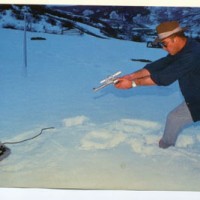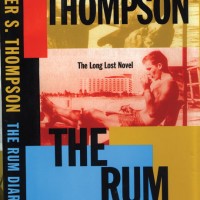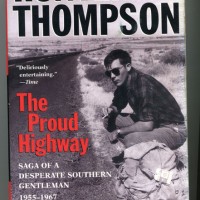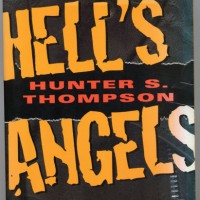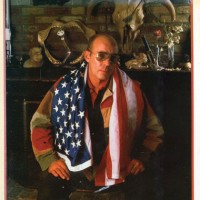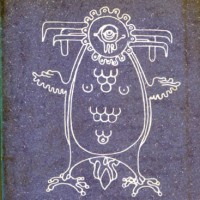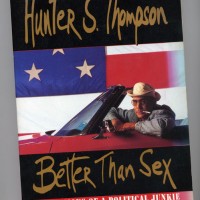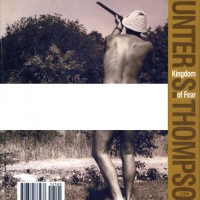Politics, Hippies and Hell's Angels
- Details
- Published on Monday, 03 September 2012 15:40
- Written by Kevin Kizer
As a writer, Hunter S. Thompson means different things to different people across several generations, which is a testament to his talent. It's no exaggeration to say his books have transcended social barriers and created a common thread among diverse groups of people: law enforcement officials and restless youth, politicians and the counterculture, professional journalists and armchair quarterbacks to name a few. If this sounds a bit bold, consider his body of work.
His first published book, "The Hell's Angels:", was the first detailed exposé written from within the motorcycle club. His commentary on the workings of the Angels – including their motivations and interests – were so insightful and accurate that the book was used as a training manual for many police departments on how to deal with the burgeoning motorcycle club movement.
Probably his most famous work, "Fear and Loathing in Las Vegas", became a living bible for the drug culture and rebel youth, having a similar impact as "On The Road" did in the previous decade. It also had a tremendous impact on the world of journalism, as did its predecessor, a short piece written for Scanlan's Monthly rather subtly titled, "The Kentucky Derby is Decadent and Depraved."
His following book, "Fear and Loathing on the '72 Campaign Trail", was and still is a must-read for politicians and those whose livelihoods depend on understanding the workings of the political arena. His further writing on politics had politicians of all stripes calling for the advice of the Good Doctor, which he was sometimes called.
What makes these works so special is not so much the subject matter, but the way in which Thompson wrote. His form was wild and breathless, catching action as it happened (sometimes with a tape recorder), cutting through the crap, fictionalizing here, hallucinating there and making some semblance of sense of it all later. It's no surprise to learn that Kerouac was one of Thompson's biggest influences. Thompson's form became known as "Gonzo Journalism," a term coined by Thompson's good friend, occasional cohort and fellow journalist, Bill Cardoso.
While to the public Thompson was often portrayed as a subversive, drug-addled novelist, the truth is that he was a sports writer, as well as a self-proclaimed political addict. His road to literary success, like most authors/journalists, was a difficult journey to say the least.
WRITING ABILITY CAME NATURALLY
Thompson's ability as a writer with a ruthless con-man streak was evident early in his life. He was born July 18, 1937 in Louisville, Ky. As a youth, he had several run-ins with the law but was regarded as brilliant by his high school English teacher. Even at that age he wrote in a sardonic style constantly attacking the status quo.
After graduating – which he did while in a jail cell, serving a six-week sentence for robbery as his fellow graduates were receiving their diplomas – Thompson enlisted in the Air Force and graduated from Scott Air Force Base in Belleville, Ill. In 1956, he was assigned to Eglin Air Proving Ground in Pensacola, Fla., which was where he first began in the field of journalism.
When he arrived, he discovered that the base's newspaper was looking for a sports editor. Since he didn't really fit in with armed forces lifestyle, Thompson conned his way into the position by claiming to have a journalistic background. As Thompson wrote at the time, "The people who hired me didn't bother to check too closely on my journalistic background...I've managed to keep them in safe ignorance for about a month now."
A quick learner and gifted writer, Thompson soon caught on and excelled as a journalist. He began moonlighting for a competing newspaper in the area (under the pseudonym Thorne Stockton) and was helped by a sergeant who respected Thompson's talent enough to overlook his numerous infractions of military protocol.
Thompson was always interested in literature and knew that his best bet in life was as a writer. He studied the classics but was particularly taken with modern writers like Fitzgerald, Hemmingway, Ayn Rand and an emerging group known as the Beats. He had an interesting way of studying the writers he loved. He would transcribe their works on his typewriter in an effort to discover rhythm and flow of each writer's writing style. He went so far as to re-type "The Great Gatsby" and "A Farewell to Arms" in their entirety.
In October of 1957, Thompson was delighted to receive an honorable discharge from the Air Force. After the service, he spent time in Pennsylvania and New York, living nearly in poverty. He was fired from one newspaper job because he kicked in a vending machine that cheated him. It was at this time that he began writing his Fitzgeraldian novel, "Prince Jellyfish", which remains unpublished in its entirety.
THE CARIBBEAN BECKONED
By 1959, he was getting tired of the bitter Eastern climate and became determined to find work in the Caribbean. He responded to an ad for a sports editor for the San Juan Star in Puerto Rico in typical Thompson style: "I have given up on American journalism. The decline of the American press has long been obvious, and my time is too valuable to waste in an effort to supply the 'man on the street' with his daily quota of cliches, gossip, and erotic type. There is another concept of journalism, which you may or may not be familiar with. It's engraved on a bronze plaque on the southeast corner of the Times Tower in New York City."
He received no job offer but got a cynical reply from the young editor of the magazine named William Kennedy, who went on to win the Pulitzer for the novel "Ironweed." Although Kennedy rejected him, Thompson was able to secure a job on El Sportivo, a new English-language weekly bowling publication in San Juan.
Things in San Juan did not go as smoothly as Thompson had hoped. "Prince Jellyfish" continued to be ignored, eliciting little more than form letters from publishers; El Sportivo was bombing and his paychecks were consistently bouncing, if they came at all; and he was becoming increasingly jealous of his girlfriend, Sandy Conklin, who was living in New York.
But soon his personal life turned around as Conklin joined him in San Juan and became his common-law wife. He also received the occasional infusion of cash for writing freelance articles for the New York Herald Tribune and Louisville Courier-Journal, as well as working as a male model.
Nine months later the pair returned to New York. Thompson began working on a novel (which became a 2011 film) called "The Rum Diary," which detailed his time in the Caribbean. A few months later, Thompson and high school buddy Paul Semonin hitchhiked to the West Coast searching for work as writers.
Thompson settled for a time in Big Sur while Semonin moved to Denver. While in Big Sur, Thompson wrote an article on the well-known creative haven for Rogue magazine and earned his largest paycheck to date: $350. It also earned him an eviction from his Big Sur home: his landlady read the story and did not approve of his characterization of the local inhabitants.
Ever the restless writer, in mid-1962 Thompson set off abroad, this time to South America as a writer for The National Observer. It was at this time he first gained the attention of the national media. His pieces on South America received high praise throughout the journalistic community. He also gained a new drinking buddy, Charles Kuralt of CBS News.
A year later he was back in the States to make his common law wife his official wife. Later in 1963, the Thompsons moved to Aspen, Colo., staying with Semonin before settling in the small mountain hamlet of Woody Creek.
GONZO JOURNALISM, BIKERS AND POLS
One of the biggest impacts on Thompson's life occurred on Nov. 22, 1963 when John F. Kennedy was shot. He felt it signaled a turn in society. In a letter to Semonin, he wrote: "This savage unbelievable killing, this monstrous stupidity, has guaranteed that my children and yours will be born in a shitrain."
In another letter to William Kennedy, who was back in New York, he used the phrase "fear and loathing" to describe the way he felt after the murder.
What became Gonzo journalism started in 1964 as "impressionistic journalism," in Thompson's words. It was the opposite of the time-honored tradition of objective journalism. Thompson felt that sometimes the most interesting aspect of a story was not just the facts and information but what was going on from the writer's perspective. The writer became part of the story.
Thompson continued to write for The National Observer, and the publication loved his fresh approach. He also had his first foray into "politics": he began soliciting President Johnson to appoint him Governor of Samoa. For awhile, amazingly enough, the Johnson administration remained in contact with Thompson. Thompson eventually withdrew his offer in outrage over the President's handling of Vietnam.
The Thompsons moved back to San Francisco, where Thompson tried to get writing work from The Nation. The magazine gave him the idea to write about the Hell's Angels. After convincing the decidedly suspicious Angels, he spent a year with the motorcycle club, not as a journalist but almost as a member. The Angels distrusted journalists because of their consistent maligning, so they went to great lengths to ensure that Thompson was "one of them." His ability as a con man came through for him once again. His articles received much praise and led to his first publishing contract with Ballantine Books.
Thompson became ingrained in the Hell's Angels' culture and presented them in a fair light, something that had not been done until this time, even though he once got a severe beating at the hands of the Angels. There are numerous accounts of what happened, but one thing is for sure: the old Angel law of "when you fight one Angel, you fight them all" was definitely true. Thompson even included the beating as the postscript to the book.
In early 1966 Thompson finished his book. To say it was a success would be an understatement.
The first edition of "Hell's Angels: The Strange and Terrible Saga of the Outlaw Motorcycle Gangs" sold out immediately and it broke into the New York Times bestseller list, although Thompson had a few problems on the book tour, showing up drunk for most interviews.
In 1968 Thompson began nurturing another addiction he'd toyed with for years: politics. It was also the beginning of a friendship with Oscar "Zeta" Acosta, a radical, militant lawyer from East Los Angeles. Acosta, who was one of the driving influences behind the burgeoning Brown Power scene in L.A., met Thompson on a visit to Aspen in 1967. The Thompson-Acosta correspondences are some of the most entertaining correspondences in print.
While in New York, Thompson met with his publishers and he pitched the idea of a book on "The Death of the American Dream." Thompson's idea was to write a book that would "do up a massive indictment, focusing on the murderers of the so-called 'American Dream.'" This related to the "fear and loathing" he felt after JFK's assassination. His main targets were the Pentagon, the Joint Chiefs and Lyndon Johnson, to name a few. For the next two years, the book was the focal point of Thompson's energies. Although it never appeared in print, it helped set Thompson on the path to creating two of his most influential and best known works, "Fear and Loathing in Las Vegas" and "Fear and Loathing: On the Campaign Trail '72."
In 1969, Thompson was hired by Playboy to do a piece on Jean-Claude Killy, an Olympic skier turned pitchman. What Thompson returned with was the first true piece of Gonzo literature to be published, entitled "The Temptations of Jean-Claude Killy." But it was never published in Playboy because the editors felt it was too mean-spirited. The piece was eventually published in Ramparts.
Soon after the Killy piece, Thompson and English illustrator Ralph Steadman were sent to cover the Kentucky Derby for the magazine. The resulting article, "The Kentucky Derby Is Decadent and Depraved," provided readers with a vicious yet hilarious description of the event. Steadman's illustrations were done in lipstick and were perverse and humorous, much like Thompson's writing. It was the beginning of a life-long working relationship.
Thompson's next target was an old nemesis who had returned stronger and smarter: Richard Nixon. By fluke, in 1968 Thompson was allowed to ride along with the candidate in a car and discovered that the washed-out politician was "brighter and therefore more dangerous than I surmised. He was a brute in need of extermination."
Thompson and Nixon did have one thing in common: an addiction to football. Thompson recalled the depth of Nixon's knowledge, including his ability to recall a seemingly minor, but strategically crucial play from the previous year's Super Bowl.
However, it wasn't the interaction with Nixon that pushed Thompson into politics so much as the violence that erupted during the Democratic National Convention in Chicago in 1968, which Thompson was covering at the time for material for a book.
FREAK POWER POLITICS
Thompson returned to his home in Woody Creek a new man with a new mission: to beat the bastards at their own game. Thus he began what is still one the most memorable and strategically effective anti-campaigns in the history of the U.S: the Freak Power ticket.
It was the fall of 1969 and the Aspen Mayoral election was coming up. Thompson was so disgusted by the candidates that he and a group of local friends ran their own candidate for mayor: a 29-year-old hippie bike-racer named Joe Edwards. Their campaign began three weeks before the election and nearly caused the upheaval of the small Western town.
This wasn't a whim or joke. Thompson noticed voter turnout was low in previous elections and determined it was mostly 18- to 25-year olds who were missing. So the theory he perpetuated was that if any candidate could garner the young vote, they would have the power to not necessarily win, but at least change the outcome of the election.
With only three weeks to organize, Joe Edwards lost the mayoral race by one vote. In reality, Edwards won the original vote by six – but lost the absentee ballot by seven. As Thompson wrote at the time, "we scared the living shit out of the Aspen Power Structure."
In analysis, the group that really cost the Freaks the election wasn't the conservatives but the old-school liberals who supported the Democratic candidate. They were so scared of the possibility of a Freak Power mayor they cannibalized their own candidate and voted Republican.
The close loss whetted Thompson's appetite and the next year the Freak Power Party entered the political arena with a vengeance. And not only in Aspen: Freak Power blossomed in Kansas, Berkeley and Los Angeles, where Thompson's buddy, Acosta, garnered 110,000 votes out of 2 million cast in the L.A. County sheriff race.
Thompson himself ran for sheriff is Aspen and his platform was pretty direct: an end to the selling-off of Aspen. This is an excerpt of from one of the Freak Power ads:
"And now we are reaping the whirlwind-big-city problems too malignant for small-town solutions, Chicago-style traffic in a town without stoplights, Oakland-style drug busts continually bungled by simple cowboy cops who see nothing wrong with kicking handcuffed prisoners in the ribs while the sheriff stands by watching, seeing nothing wrong with it either."
The Freak Party campaign was unique and unsettling. The Party posters bore a red fist clutching a peyote button. Thompson shaved his head clean. They proposed changing the name of Aspen to Fat City to scare off investors. It's hard to gauge if people actually believed this. On the question of drugs, as Thompson wrote, "We ran straight at the bastards with an out-front mescaline platform." Thompson relented a bit before the election, saying he would refrain from taking mescaline while on duty.
In the end Thompson lost the race 1,500 to 1,065. He delighted in the fact that he won the city vote, where the Freaks made up 30 percent of the electorate. But he was trounced in the county vote, even losing 300 to 90 in his home precinct of Woody Creek.
Perhaps the most clear description of Freak Power came from one of the many campaign posters written by Thompson: "This is the real point: that we are not really freaks at all – not in the literal sense – but the twisted realities of the world we are trying to live in have somehow combined to make us feel like freaks. We argue, we protest, we petition – but nothing changes."
Thompson's campaign attracted quite a bit of attention. But the most interested media outlet was Rolling Stone. The owner and editor, Jann Wenner, became a good friend and recurring nemesis of Thompson's. Much like the Acosta letters, the correspondences between the two are legendary.
Thompson's first article for Rolling Stone, "The Battle of Aspen," was published in the October 1, 1970 issue. It was around this time that Thompson stumbled upon the city of Las Vegas.
FEAR AND LOATHING
In two issues in 1971, there appeared articles by the author Raoul Duke entitled "Fear and Loathing in Las Vegas." As Douglas Brinkley wrote, the book "follows Duke and his three-hundred pound Samoan attorney, Dr. Gonzo, to Las Vegas, ostensibly to cover a motorcycle race and then a convention of district attorneys." Raoul Duke had become Thompson's alter ego previously in correspondences. It allowed him to say things that he couldn't under his own name and to blur fact, fiction and fantasy together.
Thompson felt he had a classic on his hands and a few people echoed this. However, when "Fear and Loathing in Las Vegas" was published in book form it did not sell nearly as well as "Hell's Angels." But it did solidify Thompson's conviction in what he was doing.
Thompson's next big job for Rolling Stone was covering the Democratic Party during the 1972 election. Thompson harbored a basic hatred for typical politicians but became quickly enamored of South Dakota senator George McGovern. McGovern ran on an anti-Vietnam ticket and was, in Thompson's eyes, the more politically correct manifestation of the Freak Party. However, after McGovern won the Democratic nomination on an insurgent campaign, he relented to party politics and, instead of staying on the path that got him the nomination, tried to unite the base, thus losing the alternative voter base that had put him in position to take the presidency from Nixon.
In the end, McGovern lost in a landslide but Thompson turned out what still stands today as the preeminent and most insightful piece ever written on a presidential election, "Fear and Loathing: On the Campaign Trail '72." And he made a life-long friend in George McGovern.
Over the next few years, Thompson covered the withdrawal of American troops in Vietnam, the fall of Laos and put together an often-overlooked political summit. In 1974, Thompson along with a group that included Wenner, ex-RFK campaign veterans and McGovern strategists gathered in Elko, Nev. to create a liberal strategy for political victory following the fall of Nixon. What resulted, as Thompson recalled, was "gibberish."
Around this time Thompson learned of the disappearance of Oscar Acosta in the spring of 1974. To this day, it's not known what happened to the "Brown Buffalo" who "stomped on the terra" as Thompson described him. Some believe he went underground, but most others feel he was murdered by drug traffickers. To this day the case has not been solved.
As Nixon fell apart and, along with him, the Republican Party, Thompson became more involved in national politics. He became a friend, proponent and unofficial advisor to Jimmy Carter before and during his run for the presidency in 1976. Thompson even stayed at Carter's home in Plains, Ga., for a couple of days in 1975. When there were rumors about Thompson possibly running for president, Carter sent Thompson a note saying he'd drop out in support of Thompson.
Thompson didn't run, but a prediction he made two years previously, when Carter was known as "Jimmy-who?" in the press, proved to be true as Carter trounced Ford to become President. During the '80s, Thompson continued to be eerily accurate in his political predictions, especially during the Iran-Contra affair. However, one prediction he made that didn't come true was in regards to a certain vice president going to jail for a long, long time. Just the opposite came true – George H.W. Bush became president. Thompson once again had a new target, although he wrote a letter to the newly elected president asking for a job.
The '90s opened on a high note for Thompson. While supporting and actively campaigning for Bill Clinton, he sensed a similarity between the new president and Nixon: they both were feral political animals. Thompson's resulting novel was "Better than Sex: Confessions of a Political Junkie."
COUNTER-CULTURE GODFATHER
As the '90s progressed, Thompson stature as a counter-culture godfather grew. After all, he was one of the only voices from the time who was still pertinent and coherent. He continued to appear occasionally in print, but largely remained in his "heavily fortified compound" in Woody Creek.
What was arguably Thompson's most successful venture came in 1998 when "Fear and Loathing in Las Vegas" was finally made into a major motion picture. Thompson had been pitching the idea for 30 years. The film was directed by Terry Gilliam, with Johnny Depp playing Thompson's character and Benicio Del Toro playing Dr. Gonzo. It has been said that Depp had a hard time shaking off the character after production finished.
Thompson's career came full circle in 2001 when he became a sportswriter and weekly columnist for ESPN.com's "Page 2" section. His column, called "Hey Rube!", showed the old doctor still had his gonzo, writing scathing indictments of everything from the second Bush administration to the NBA as a whole.
To summarize Thompson's career is difficult – which is why this story is so long. He wrote about everything from the Hell's Angels and the dope scene of San Francisco to Super Bowls and Presidential elections. His list of friends included the likes of Pat Buchanan, George McGovern and Jimmy Carter, as well as Ken Keseyw, William Burroughs and Warren Zevon.
Sadly, Hunter S. Thompson, who carried the beat romanticism of Jack Kerouac, the political conviction of Allen Ginsberg and the acidic skepticism of William S. Burroughs into the world of popular journalism, died a Hemingway-esque death in Colorado on Feb. 20, 2005.
While his death created shockwaves across the literary world, his funeral created a big laugh. It was Thompson's dream, as shown in a '78 documentary, to have his ashes shot from a giant tower with a double-thumbed fist clenching a peyote button. His friends, particularly Johnny Depp, obliged. On August 20, 2005 – before a crowd of nearly 300 invited guests including Senator John Kerry and former Senator McGovern; Ed Bradley and Charlie Rose from 60 Minutes; along with Depp, Jack Nicholson, John Cusack, Benicio del Toro, Sean Penn and Josh Harnett – Hunter S. Thompson's ashes were fired from a 153-foot tower to the tune of Norman Greenbaum's "Spirit in the Sky" and Bob Dylan's "Mr. Tambourine Man."















































